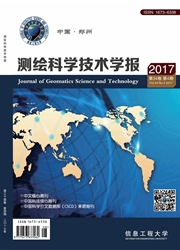

 中文摘要:
中文摘要:
在分析比较经验模态分解(EMD)、小波变换(Wavelet)和独立分量分析(ICA)优缺点的基础上,提出一种新的EMD-Wavelet-ICA耦合模型。该模型充分利用了EMD的自适应性,对原始信号进行分解获得不同频率的模态函数(IMF),采用标准化模量的累计均值对IMF进行尺度划分;进而分别采用Wavelet和ICA对高频和低频IMF进行降噪,将降噪后的IMF进行多尺度重构,获得降噪后的信号;采用信噪比、标准差、偏差和相关系数等指标对降噪效果进行评价。仿真数据和GPS坐标序列的处理结果表明:与EMD模型和EMD-ICA模型相比,新模型的标准差、偏差均有不同程度的减小;信噪比和相关系数有一定程度的增大,可以获得更好的降噪效果。
 英文摘要:
英文摘要:
Based on analyzing the advantages and disadvantages of empirical mode decomposition( EMD), wavelet transform(Wavelet), and independent component analysis(ICA), a novel EMD-Wavelet-ICA coupled model was proposed. The proposed model could decompose an original signal to different frequencies intrinsic mode functions (IMF), which could be divided into two parts with an index named mean of standardized accumulated modes ( MSAM). Then, the high frequency part was de-noised by Wavelet, and the low frequency part by ICA. Then, the de-noised IMFs were reconstructed, and several indexes namely signal to noise ratio(SNR), standard deviation (STD), bias and correlation coefficient(R), were employed to evaluate the de-noised results. Two experiments were carried out and the results show that the proposed model can decrease the STD and Bias values, and increase SNR and R values to some extent, compared with the two pre-existing model namely EMD and EMD-ICA.
 同期刊论文项目
同期刊论文项目
 同项目期刊论文
同项目期刊论文
 期刊信息
期刊信息
